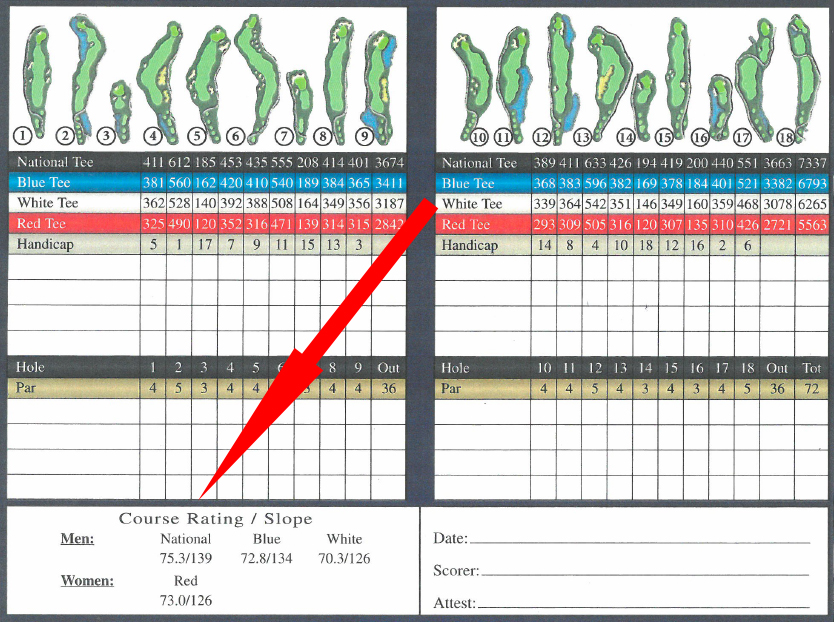Three important numbers every golfer should know before they hit the first tee at a course they have never played, is Course Rating, Slope and length. These three numbers provide a ton of information about a course and can help the average golfer enjoy the game even more.
Accurate course ratings require hundreds of accumulated rounds. Thus, the course rating newly renovated, or opened courses may not be as helpful as mature courses on which the USGA has had thousands of rounds to factor in seasonality, and experience over time.
As golfers have become more aware of ‘teeing it forward,’ understanding course rating, slope and distance have become important factor in determining which is the correct tee for them.
What is Course Rating?
When you look at a scorecard of a Par 72 golf course the rating may be lower, or higher than the posted par. Course rating is a number, plus, or minus normal par, that a low handicap golfer would be expected to shoot for 18 holes.
A Par 72 golf course with a course rating of 73.5 is a difficult course and a gentle warning to the average golfer to choose a more forward tee than he might normally use.
Conversely a 68.5 rating on a Par 72 course would alert the golfer that the course is not quite as difficult, relative to par, and thus he may want to move back one tee box.
What is Slope?
The posted Slope of a course is a relatively new concept. The USGA found in the 1980’s, they could determine, through collected handicap data, the relative difficulty of a course for the low handicapper versus the difficulty for a higher handicap golfer.
For example, a course with several forced carries over water, or other hazards, elevated greens that require a higher ball flight over greenside bunkers, plus the severity of the bunkering around the course, will have a greater impact on the scorecard of an average golfer than on that of a scratch golfer.
Slope is thus that difference of difficulty for a low handicap golfer versus a high handicap one.
Why is this important?
On courses that you are not familiar it is especially important to understand slope and course rating to help choose which set of tee boxes is right for you. Also checking the overall course distance is important, as well.
Distance
With courses stretching in excess of 7,000 yards, distance is one of the most important factors in choosing which tees are right for you. There are many formulas to help decide which tee to choose, but an easy one to remember is to multiply the distance you normally carry your 5 iron by 36.
Example:
If you carry your 5 iron 100 yards X 36 = 3,600 yard course
If you carry your 5 iron 150 yards X 36 = 5,400 yard course
If you carry your 5 iron 200 yards X 36 = 7,200 yard course
The PGA of America created this chart to suggest recommended course yardage based on the distance golfers hit their driver.
| Avg. drive | Recommended Tees |
| 300 yards | 7,150-7,400 yards |
| 275 yards | 6,700-6,900 yards |
| 250 yards | 6,200-6,400 yards |
| 225 yards | 5,800-6,000 yards |
| 200 yards | 5,200-5,400 yards |
| 175 yards | 4,400-4,600 yards |
| 150 yards | 3,500-3,700 yards |
| 125 yards | 2,800-3,000 yards |
| 100 yards | 2,100-2,300 yards |
Even though driver distance is an important factor, course rating and slope should be taken into consideration, when playing a new golf course.
The USGA and Course Raters play in important role in the overall enjoyment of the game. This is especially true for golfers that travel and play new golf courses. Look over that scorecard before you hit the first tee, choose the correct yardage for your game and have more fun on the course.










